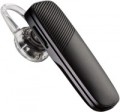Connection
—
Mini-Jack (3.5 mm). Mini-Jack is one of the most popular wired connectors. However, it is not used in Bluetooth headsets, and it is extremely rare in other specialized accessories and predominantly is an auxiliary feature. So, in speakerphones, mini-Jack is usually responsible for connecting several devices to each other, and in car kits, for outputting sound to the radio or standard car acoustics. Note that in this case, the headphone jack is not considered a 3.5 mm jack, although it is most often performed in this format.
— USB A. The classic USB A computer connector, which is gradually being replaced by the USB-C connector. The meaning and application of this connection depends on the type of device. So,
USB in speakerphones is a standard port for wired connection — both to computers and to specialized communication systems. And in Bluetooth headsets, this means that it is equipped with a USB adapter for connecting to a PC without a Bluetooth module.
— USB-C. A port similar in purpose to the one described above, but with a different, more modern, symmetrical shape that does not require specific connection, and correspondingly increased speeds.
—
Bluetooth. Nowadays, Bluetooth is actually the standard interface for wirelessly connecting headsets and other audio accessories to gadgets. This technology is not only well suited for audio tra
...nsmission, but can also be used for additional functions such as remote control. Features vary by version, the latest being Bluetooth v5. The communication range in this case can reach 10 m, and built-in Bluetooth modules are available in all modern smartphones, most phones, tablets and laptops, they can also be used in PCs and many other types of gadgets.Range
The maximum distance from the headset to the signal source at which it can be used normally.
Note that this indicator is stated for optimal conditions; the actual communication range is often lower than the claimed one due to obstacles in the signal path and extraneous interference. However, the minimum range for Bluetooth accessories is actually
10 m, which in fact, usually, gives at least 5 – 6 m — and this is quite enough for comfortable use. There are also more "long-range" solutions, with a range of
up to 50 m or
even more. However, it is worth remembering that Bluetooth is a two-way communication, and the range claimed in the specs must be supported not only by the headset itself, but also by the device with which it is used.
Also note that a long range means not only the ability to communicate over a long distance, but also a good ability to work through obstacles such as thick walls. Therefore, a powerful Bluetooth device may be necessary even at a short distance — if there are obstacles at this distance.
Battery life
Time of operation of the self-powered device (see "Power") on one battery charge.
Usually, the battery life in the talk mode is meant, when the device consumes the most energy. In headsets with
high-capacity batteries, this battery life can be 9 hours or more. However, talking for several hours without pauses is almost impossible, so in fact the operating time is noticeably longer than in the specifications. So, a headset with an operating time of the same 9 hours is most likely quite enough for a 12-hour work shift, even if you have to constantly make calls through it; and if we are talking about only 5 – 6 calls per day, then the charge is guaranteed to last for several days, or even a week. At the same time, the difference in the claimed operating time is usually quite consistent with the difference in actual battery life, and it is quite possible to compare the real capabilities of different models by it.
USB charging port
The type of connector used to charge the built-in battery of Bluetooth headsets, more precisely, to connect an external charger. The role of such a device can be played by a network or car adapter, a power bank, or even a USB port on a PC or laptop (if you have the appropriate cable).
— microUSB. A smaller version of the USB connector designed for portable devices. It appeared quite a long time ago, but it does not lose popularity nowadays, despite the active implementation of the USB-C port.
— USB-C. A miniature USB connector, positioned, among other things, as a potential successor to microUSB. Unlike its predecessor, it has a double-sided design, thanks to which the plug can be inserted into the socket in either direction. It is still relatively rare, but the situation is likely to change in the coming years.

